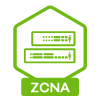Port/Interface Dampening?
Does anyone know if this is possible to configure on a Zyxel switch? I was unfamiliar with the term until recently.
We will be configuring two Dell PowerSwitches in VLT (Dell's version of MLAG) with a LAG from the VLT domain toward a XGS2210-52HP. Dell's VLT Technical guide suggests dampening (or equivalent) should be configured on the attached device (XGS2210-52HP). Dampening will temporarily hold an interface down after a VLT peer device reload. A reload is detected as a flap: the link goes down and then up. Suggested dampening time is 30 seconds to 1 minute.
The attached devices are not aware of that activity and upon activation of a physical interface, the connected device will start forwarding traffic on the restored link, despite the VLT peer unit being still unprepared. It will black-hole traffic.
Accepted Solution
-
Hi @RSaull,
We appreciate your valuable feedback. Upon thoroughly reviewing Dell's documentation, it's confirmed that our XGS2210 model currently does not support a function analogous to Dell's VLT application.
Regarding the alternative of using STP, our analysis indicates that this would not be a viable solution in this context. Dell's documentation reveals that their switches utilize RSTP, with port dampening enabled on the access switch ports. Based on this setup, it's apparent that simply enabling STP on our end is unlikely to effectively address the issue of port flapping and its associated challenges.
I have created an idea post for you.
Zyxel Melen0
All Replies
-
Hi @RSaull,
Thanks for asking. Since I'm not familier to this function, may I know
- What will happen if the access switch does not enable this function?
- What kind of scenario/topology needs this function?
- Is the function you want to achieve the same as the document described?
Thanks in advance.
Zyxel Melen0 -
- From Dell's VLT Technical Guide, as mentioned in my original post, traffic will be "blacked-holed" if the attached switch starts to forward traffic to the Dell VLT peers when they have not fully converged. I am far from a network engineer, but from my quick search, that refers to traffic being silently discarded. There are some tasks that the VLT peers must perform after a reload before they can start receiving traffic such as:
- Establishing a peer link between the VLT peers
- Establishing a backup link (heartbeat) between the VLT peers
- Assigning a MAC address to the VLT domain (The two peers share a common one)
- We will be using the Dell switches as our SAN fabric. Our Windows Failover Cluster on one side of the VLT domain and the shared storage array on the other. However, Dell seems to recommend this for any switch attached to a VLT domain.
- Yes. Link dampening appears to be a common feature among many enterprise switches. As described in Dell's docs:
- "Interface state changes occur when interfaces are administratively brought up or down or if an interface state changes. Every time an interface changes a state or flaps, routing protocols are notified of the status of the routes that are affected by the change in state. These protocols go through the momentous task of re-converging. Flapping; therefore, puts the status of entire network at risk of transient loops and black holes. Dampening limits the notification of status to the routing protocols. Link dampening minimizes the risk created by flapping by imposing a penalty (1024) for each interface flap and decaying the penalty exponentially based on the half-time. When the accumulated penalty exceeds a certain threshold (suppress threshold), the interface is put in an Error-Disabled state and for all practical purposes of routing, the interface is deemed to be “down.”
After the interface becomes stable and the penalty decays below a certain threshold (reuse threshold), the interface comes up again and the routing protocols re-converge."
- "Interface state changes occur when interfaces are administratively brought up or down or if an interface state changes. Every time an interface changes a state or flaps, routing protocols are notified of the status of the routes that are affected by the change in state. These protocols go through the momentous task of re-converging. Flapping; therefore, puts the status of entire network at risk of transient loops and black holes. Dampening limits the notification of status to the routing protocols. Link dampening minimizes the risk created by flapping by imposing a penalty (1024) for each interface flap and decaying the penalty exponentially based on the half-time. When the accumulated penalty exceeds a certain threshold (suppress threshold), the interface is put in an Error-Disabled state and for all practical purposes of routing, the interface is deemed to be “down.”
Note: In regard to question 1 . . . We have only done some brief testing in GNS3 (Virtual environment). On more than one occasion, after simulating various failures, traffic to/from an endpoint attached to an "access" switch that was in-turn attached to the VLT domain halted after the VLT domain reloaded. I can't say for sure if this was a symptom of what was described from above, but it seems to fit what Dell says may happen without dampening.
We've wondered if STP would achieve the same thing that dampening does. From what I understand, STP does detect port flapping and can block a port as a result.
0 - From Dell's VLT Technical Guide, as mentioned in my original post, traffic will be "blacked-holed" if the attached switch starts to forward traffic to the Dell VLT peers when they have not fully converged. I am far from a network engineer, but from my quick search, that refers to traffic being silently discarded. There are some tasks that the VLT peers must perform after a reload before they can start receiving traffic such as:
-
Hi @RSaull,
We appreciate your valuable feedback. Upon thoroughly reviewing Dell's documentation, it's confirmed that our XGS2210 model currently does not support a function analogous to Dell's VLT application.
Regarding the alternative of using STP, our analysis indicates that this would not be a viable solution in this context. Dell's documentation reveals that their switches utilize RSTP, with port dampening enabled on the access switch ports. Based on this setup, it's apparent that simply enabling STP on our end is unlikely to effectively address the issue of port flapping and its associated challenges.
I have created an idea post for you.
Zyxel Melen0 -
Thanks @Zyxel_Melen.
0
Categories
- All Categories
- 441 Beta Program
- 2.9K Nebula
- 208 Nebula Ideas
- 127 Nebula Status and Incidents
- 6.4K Security
- 529 USG FLEX H Series
- 331 Security Ideas
- 1.7K Switch
- 84 Switch Ideas
- 1.3K Wireless
- 50 Wireless Ideas
- 6.9K Consumer Product
- 294 Service & License
- 461 News and Release
- 90 Security Advisories
- 31 Education Center
- 10 [Campaign] Zyxel Network Detective
- 4.7K FAQ
- 34 Documents
- 86 About Community
- 99 Security Highlight
 Freshman Member
Freshman Member



 Zyxel Employee
Zyxel Employee





